Assignment On Business And Its Environment
VerifiedAdded on 2021/02/19
|13
|3794
|21
AI Summary
Contribute Materials
Your contribution can guide someone’s learning journey. Share your
documents today.
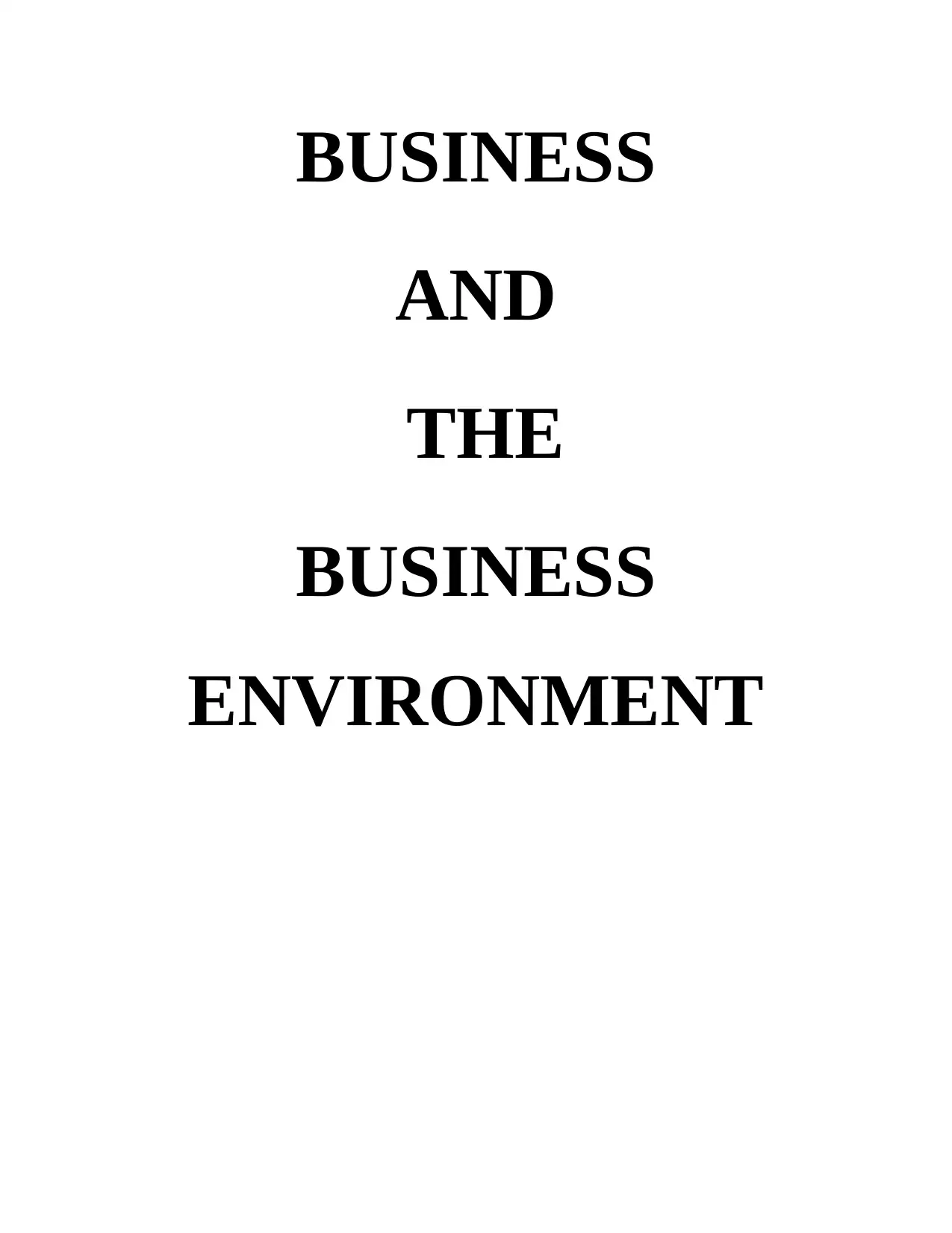
BUSINESS
AND
THE
BUSINESS
ENVIRONMENT
AND
THE
BUSINESS
ENVIRONMENT
Secure Best Marks with AI Grader
Need help grading? Try our AI Grader for instant feedback on your assignments.
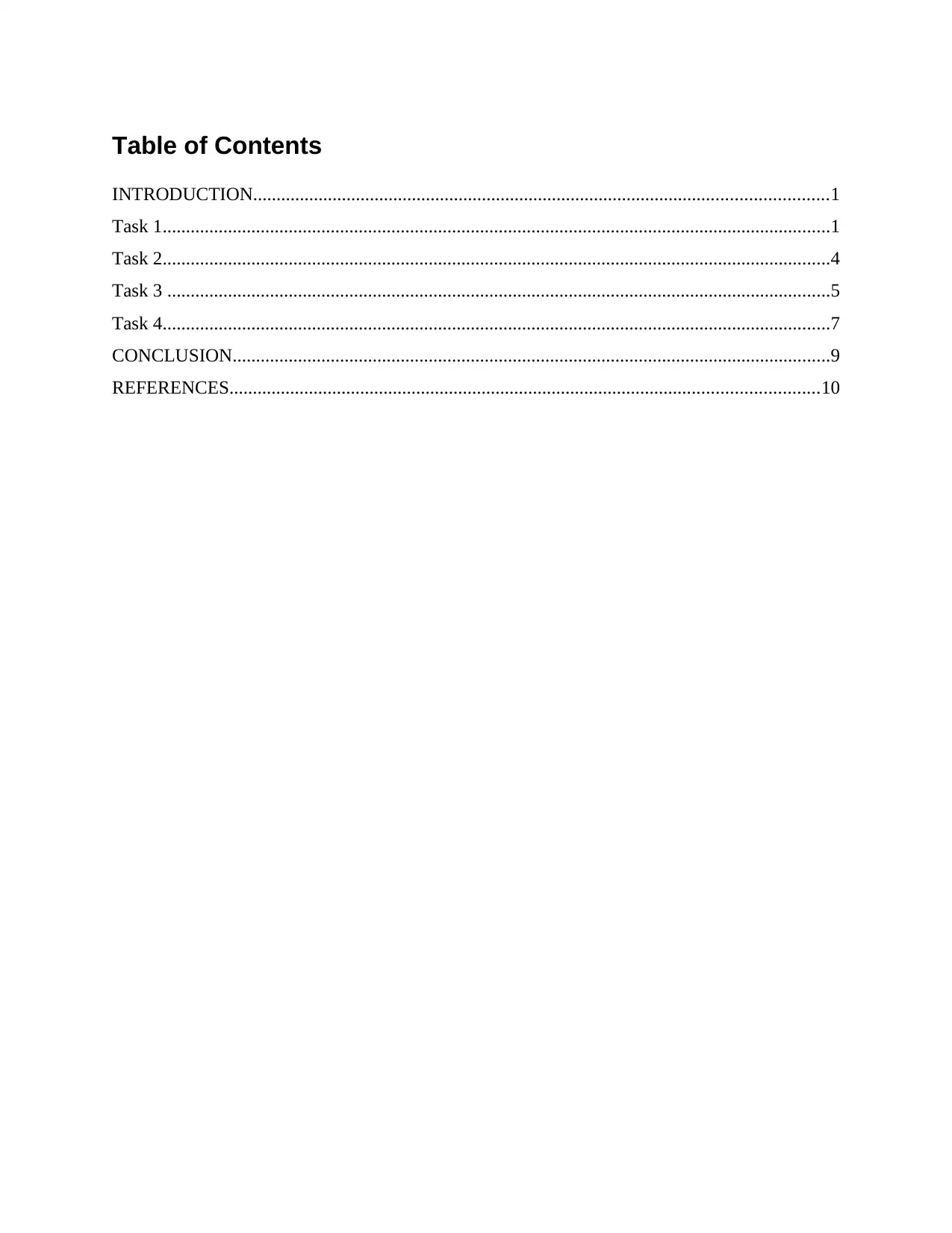
Table of Contents
INTRODUCTION...........................................................................................................................1
Task 1...............................................................................................................................................1
Task 2...............................................................................................................................................4
Task 3 ..............................................................................................................................................5
Task 4...............................................................................................................................................7
CONCLUSION................................................................................................................................9
REFERENCES..............................................................................................................................10
INTRODUCTION...........................................................................................................................1
Task 1...............................................................................................................................................1
Task 2...............................................................................................................................................4
Task 3 ..............................................................................................................................................5
Task 4...............................................................................................................................................7
CONCLUSION................................................................................................................................9
REFERENCES..............................................................................................................................10
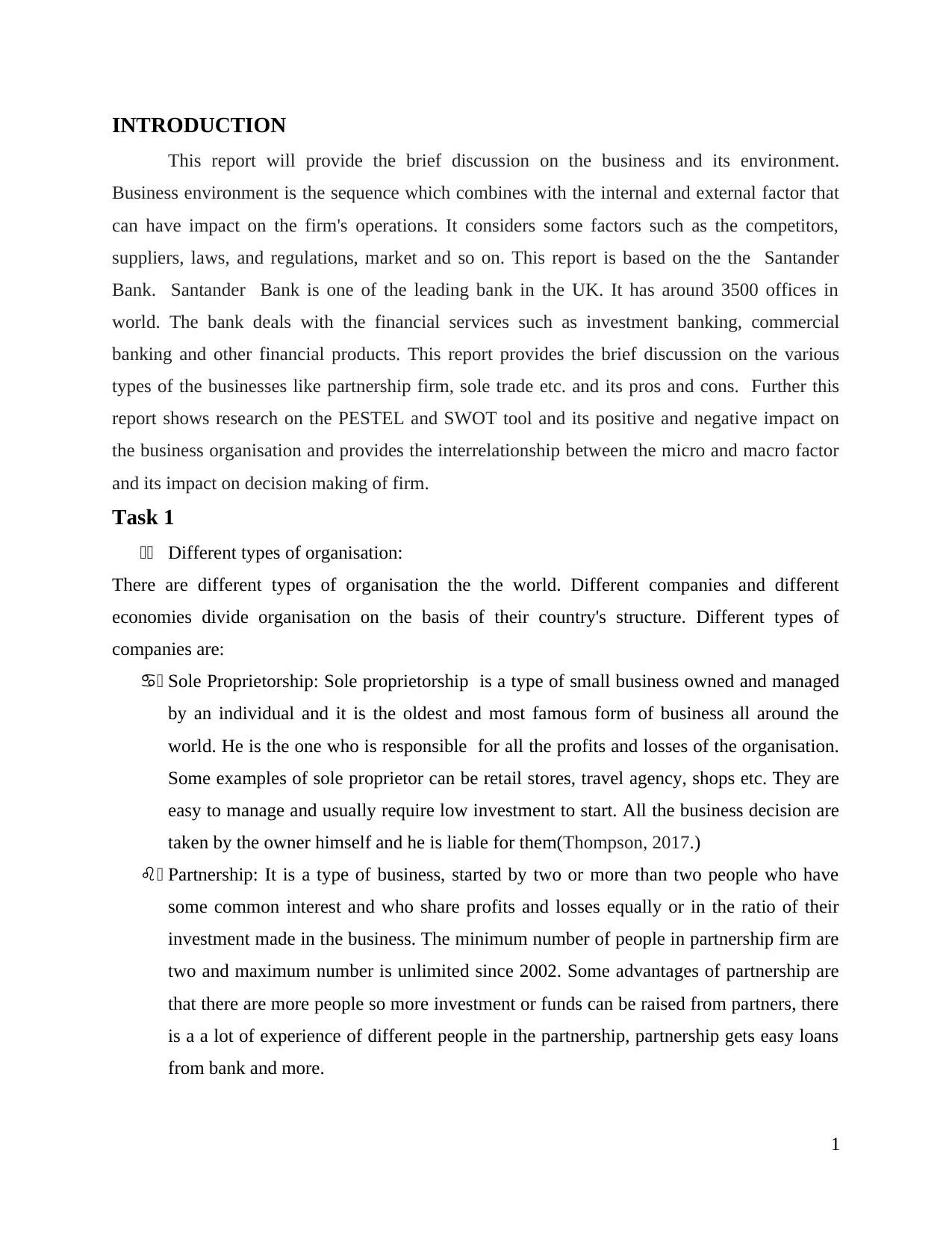
INTRODUCTION
This report will provide the brief discussion on the business and its environment.
Business environment is the sequence which combines with the internal and external factor that
can have impact on the firm's operations. It considers some factors such as the competitors,
suppliers, laws, and regulations, market and so on. This report is based on the the Santander
Bank. Santander Bank is one of the leading bank in the UK. It has around 3500 offices in
world. The bank deals with the financial services such as investment banking, commercial
banking and other financial products. This report provides the brief discussion on the various
types of the businesses like partnership firm, sole trade etc. and its pros and cons. Further this
report shows research on the PESTEL and SWOT tool and its positive and negative impact on
the business organisation and provides the interrelationship between the micro and macro factor
and its impact on decision making of firm.
Task 1
11 Different types of organisation:
There are different types of organisation the the world. Different companies and different
economies divide organisation on the basis of their country's structure. Different types of
companies are:
1a Sole Proprietorship: Sole proprietorship is a type of small business owned and managed
by an individual and it is the oldest and most famous form of business all around the
world. He is the one who is responsible for all the profits and losses of the organisation.
Some examples of sole proprietor can be retail stores, travel agency, shops etc. They are
easy to manage and usually require low investment to start. All the business decision are
taken by the owner himself and he is liable for them(Thompson, 2017.)
1b Partnership: It is a type of business, started by two or more than two people who have
some common interest and who share profits and losses equally or in the ratio of their
investment made in the business. The minimum number of people in partnership firm are
two and maximum number is unlimited since 2002. Some advantages of partnership are
that there are more people so more investment or funds can be raised from partners, there
is a a lot of experience of different people in the partnership, partnership gets easy loans
from bank and more.
1
This report will provide the brief discussion on the business and its environment.
Business environment is the sequence which combines with the internal and external factor that
can have impact on the firm's operations. It considers some factors such as the competitors,
suppliers, laws, and regulations, market and so on. This report is based on the the Santander
Bank. Santander Bank is one of the leading bank in the UK. It has around 3500 offices in
world. The bank deals with the financial services such as investment banking, commercial
banking and other financial products. This report provides the brief discussion on the various
types of the businesses like partnership firm, sole trade etc. and its pros and cons. Further this
report shows research on the PESTEL and SWOT tool and its positive and negative impact on
the business organisation and provides the interrelationship between the micro and macro factor
and its impact on decision making of firm.
Task 1
11 Different types of organisation:
There are different types of organisation the the world. Different companies and different
economies divide organisation on the basis of their country's structure. Different types of
companies are:
1a Sole Proprietorship: Sole proprietorship is a type of small business owned and managed
by an individual and it is the oldest and most famous form of business all around the
world. He is the one who is responsible for all the profits and losses of the organisation.
Some examples of sole proprietor can be retail stores, travel agency, shops etc. They are
easy to manage and usually require low investment to start. All the business decision are
taken by the owner himself and he is liable for them(Thompson, 2017.)
1b Partnership: It is a type of business, started by two or more than two people who have
some common interest and who share profits and losses equally or in the ratio of their
investment made in the business. The minimum number of people in partnership firm are
two and maximum number is unlimited since 2002. Some advantages of partnership are
that there are more people so more investment or funds can be raised from partners, there
is a a lot of experience of different people in the partnership, partnership gets easy loans
from bank and more.
1
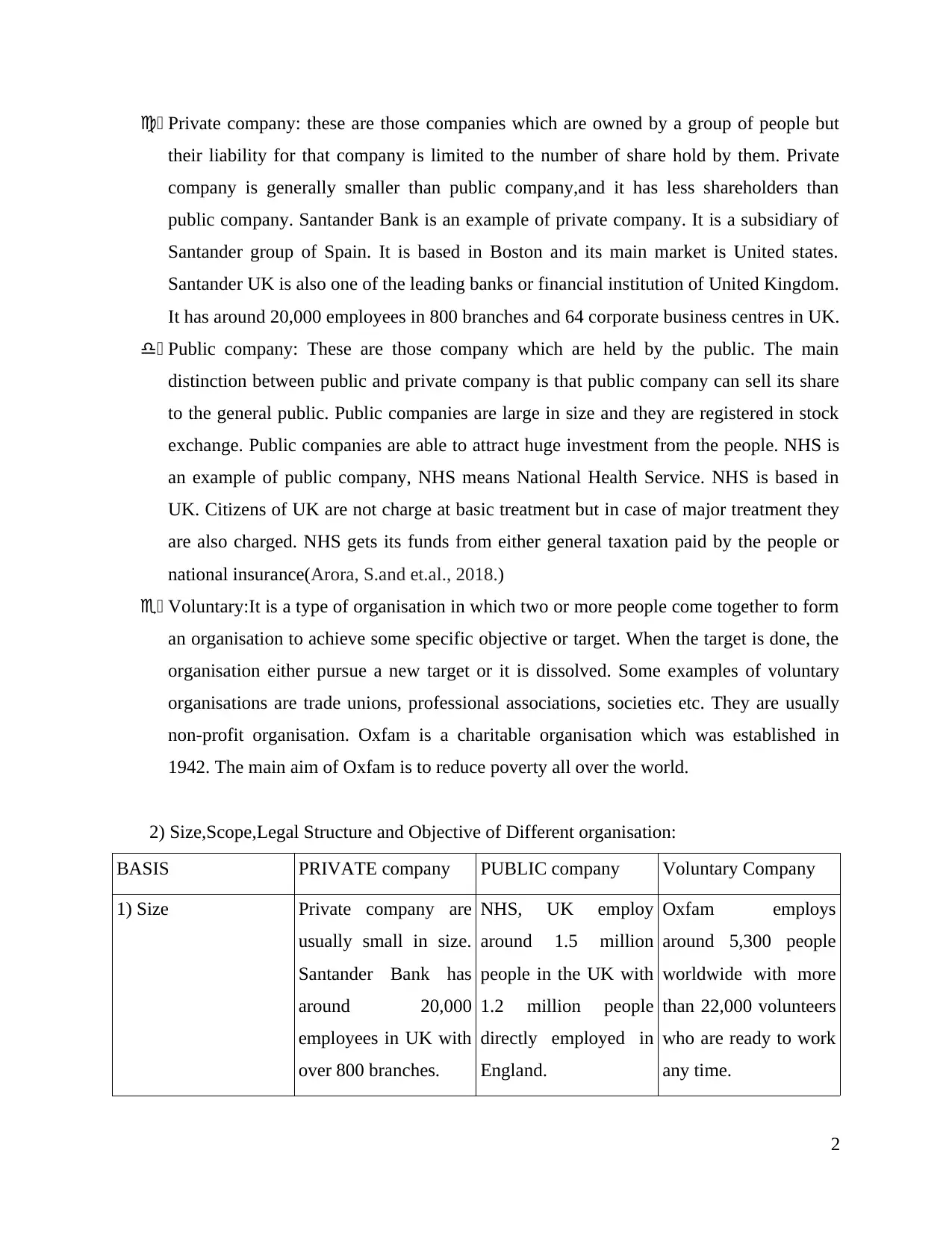
1c Private company: these are those companies which are owned by a group of people but
their liability for that company is limited to the number of share hold by them. Private
company is generally smaller than public company,and it has less shareholders than
public company. Santander Bank is an example of private company. It is a subsidiary of
Santander group of Spain. It is based in Boston and its main market is United states.
Santander UK is also one of the leading banks or financial institution of United Kingdom.
It has around 20,000 employees in 800 branches and 64 corporate business centres in UK.
1d Public company: These are those company which are held by the public. The main
distinction between public and private company is that public company can sell its share
to the general public. Public companies are large in size and they are registered in stock
exchange. Public companies are able to attract huge investment from the people. NHS is
an example of public company, NHS means National Health Service. NHS is based in
UK. Citizens of UK are not charge at basic treatment but in case of major treatment they
are also charged. NHS gets its funds from either general taxation paid by the people or
national insurance(Arora, S.and et.al., 2018.)
1e Voluntary:It is a type of organisation in which two or more people come together to form
an organisation to achieve some specific objective or target. When the target is done, the
organisation either pursue a new target or it is dissolved. Some examples of voluntary
organisations are trade unions, professional associations, societies etc. They are usually
non-profit organisation. Oxfam is a charitable organisation which was established in
1942. The main aim of Oxfam is to reduce poverty all over the world.
2) Size,Scope,Legal Structure and Objective of Different organisation:
BASIS PRIVATE company PUBLIC company Voluntary Company
1) Size Private company are
usually small in size.
Santander Bank has
around 20,000
employees in UK with
over 800 branches.
NHS, UK employ
around 1.5 million
people in the UK with
1.2 million people
directly employed in
England.
Oxfam employs
around 5,300 people
worldwide with more
than 22,000 volunteers
who are ready to work
any time.
2
their liability for that company is limited to the number of share hold by them. Private
company is generally smaller than public company,and it has less shareholders than
public company. Santander Bank is an example of private company. It is a subsidiary of
Santander group of Spain. It is based in Boston and its main market is United states.
Santander UK is also one of the leading banks or financial institution of United Kingdom.
It has around 20,000 employees in 800 branches and 64 corporate business centres in UK.
1d Public company: These are those company which are held by the public. The main
distinction between public and private company is that public company can sell its share
to the general public. Public companies are large in size and they are registered in stock
exchange. Public companies are able to attract huge investment from the people. NHS is
an example of public company, NHS means National Health Service. NHS is based in
UK. Citizens of UK are not charge at basic treatment but in case of major treatment they
are also charged. NHS gets its funds from either general taxation paid by the people or
national insurance(Arora, S.and et.al., 2018.)
1e Voluntary:It is a type of organisation in which two or more people come together to form
an organisation to achieve some specific objective or target. When the target is done, the
organisation either pursue a new target or it is dissolved. Some examples of voluntary
organisations are trade unions, professional associations, societies etc. They are usually
non-profit organisation. Oxfam is a charitable organisation which was established in
1942. The main aim of Oxfam is to reduce poverty all over the world.
2) Size,Scope,Legal Structure and Objective of Different organisation:
BASIS PRIVATE company PUBLIC company Voluntary Company
1) Size Private company are
usually small in size.
Santander Bank has
around 20,000
employees in UK with
over 800 branches.
NHS, UK employ
around 1.5 million
people in the UK with
1.2 million people
directly employed in
England.
Oxfam employs
around 5,300 people
worldwide with more
than 22,000 volunteers
who are ready to work
any time.
2
Paraphrase This Document
Need a fresh take? Get an instant paraphrase of this document with our AI Paraphraser
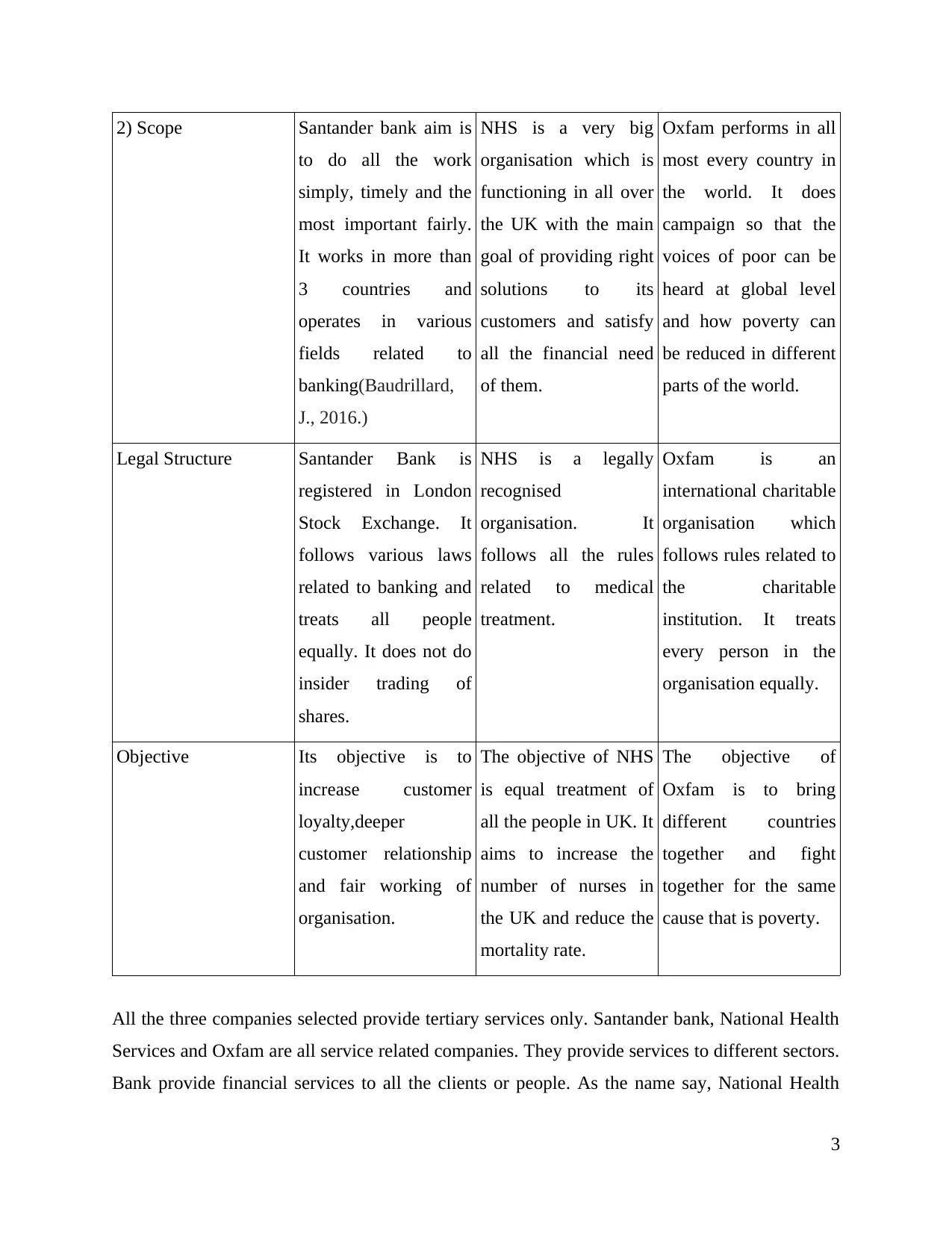
2) Scope Santander bank aim is
to do all the work
simply, timely and the
most important fairly.
It works in more than
3 countries and
operates in various
fields related to
banking(Baudrillard,
J., 2016.)
NHS is a very big
organisation which is
functioning in all over
the UK with the main
goal of providing right
solutions to its
customers and satisfy
all the financial need
of them.
Oxfam performs in all
most every country in
the world. It does
campaign so that the
voices of poor can be
heard at global level
and how poverty can
be reduced in different
parts of the world.
Legal Structure Santander Bank is
registered in London
Stock Exchange. It
follows various laws
related to banking and
treats all people
equally. It does not do
insider trading of
shares.
NHS is a legally
recognised
organisation. It
follows all the rules
related to medical
treatment.
Oxfam is an
international charitable
organisation which
follows rules related to
the charitable
institution. It treats
every person in the
organisation equally.
Objective Its objective is to
increase customer
loyalty,deeper
customer relationship
and fair working of
organisation.
The objective of NHS
is equal treatment of
all the people in UK. It
aims to increase the
number of nurses in
the UK and reduce the
mortality rate.
The objective of
Oxfam is to bring
different countries
together and fight
together for the same
cause that is poverty.
All the three companies selected provide tertiary services only. Santander bank, National Health
Services and Oxfam are all service related companies. They provide services to different sectors.
Bank provide financial services to all the clients or people. As the name say, National Health
3
to do all the work
simply, timely and the
most important fairly.
It works in more than
3 countries and
operates in various
fields related to
banking(Baudrillard,
J., 2016.)
NHS is a very big
organisation which is
functioning in all over
the UK with the main
goal of providing right
solutions to its
customers and satisfy
all the financial need
of them.
Oxfam performs in all
most every country in
the world. It does
campaign so that the
voices of poor can be
heard at global level
and how poverty can
be reduced in different
parts of the world.
Legal Structure Santander Bank is
registered in London
Stock Exchange. It
follows various laws
related to banking and
treats all people
equally. It does not do
insider trading of
shares.
NHS is a legally
recognised
organisation. It
follows all the rules
related to medical
treatment.
Oxfam is an
international charitable
organisation which
follows rules related to
the charitable
institution. It treats
every person in the
organisation equally.
Objective Its objective is to
increase customer
loyalty,deeper
customer relationship
and fair working of
organisation.
The objective of NHS
is equal treatment of
all the people in UK. It
aims to increase the
number of nurses in
the UK and reduce the
mortality rate.
The objective of
Oxfam is to bring
different countries
together and fight
together for the same
cause that is poverty.
All the three companies selected provide tertiary services only. Santander bank, National Health
Services and Oxfam are all service related companies. They provide services to different sectors.
Bank provide financial services to all the clients or people. As the name say, National Health
3
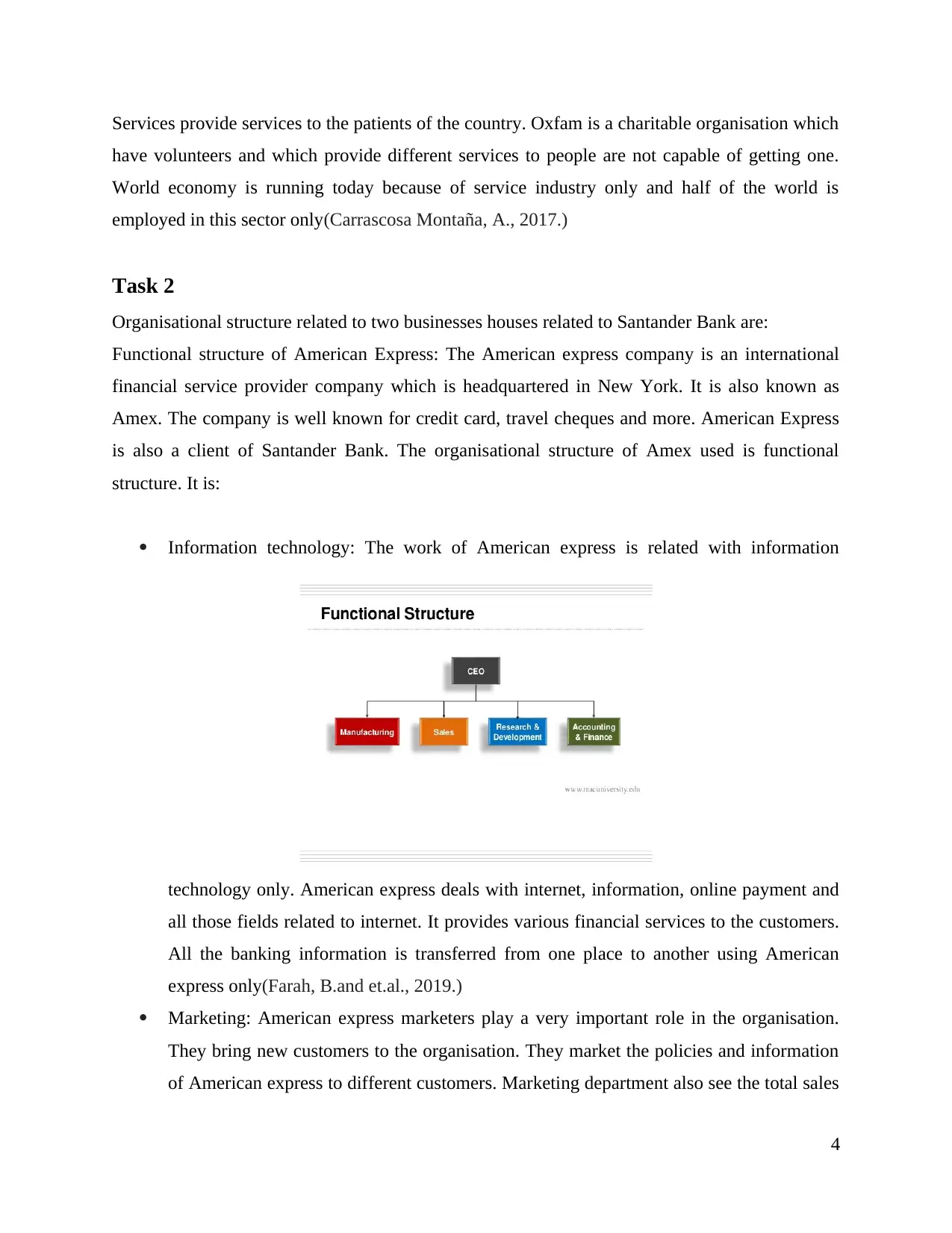
Services provide services to the patients of the country. Oxfam is a charitable organisation which
have volunteers and which provide different services to people are not capable of getting one.
World economy is running today because of service industry only and half of the world is
employed in this sector only(Carrascosa Montaña, A., 2017.)
Task 2
Organisational structure related to two businesses houses related to Santander Bank are:
Functional structure of American Express: The American express company is an international
financial service provider company which is headquartered in New York. It is also known as
Amex. The company is well known for credit card, travel cheques and more. American Express
is also a client of Santander Bank. The organisational structure of Amex used is functional
structure. It is:
Information technology: The work of American express is related with information
technology only. American express deals with internet, information, online payment and
all those fields related to internet. It provides various financial services to the customers.
All the banking information is transferred from one place to another using American
express only(Farah, B.and et.al., 2019.)
Marketing: American express marketers play a very important role in the organisation.
They bring new customers to the organisation. They market the policies and information
of American express to different customers. Marketing department also see the total sales
4
source: mac university
have volunteers and which provide different services to people are not capable of getting one.
World economy is running today because of service industry only and half of the world is
employed in this sector only(Carrascosa Montaña, A., 2017.)
Task 2
Organisational structure related to two businesses houses related to Santander Bank are:
Functional structure of American Express: The American express company is an international
financial service provider company which is headquartered in New York. It is also known as
Amex. The company is well known for credit card, travel cheques and more. American Express
is also a client of Santander Bank. The organisational structure of Amex used is functional
structure. It is:
Information technology: The work of American express is related with information
technology only. American express deals with internet, information, online payment and
all those fields related to internet. It provides various financial services to the customers.
All the banking information is transferred from one place to another using American
express only(Farah, B.and et.al., 2019.)
Marketing: American express marketers play a very important role in the organisation.
They bring new customers to the organisation. They market the policies and information
of American express to different customers. Marketing department also see the total sales
4
source: mac university
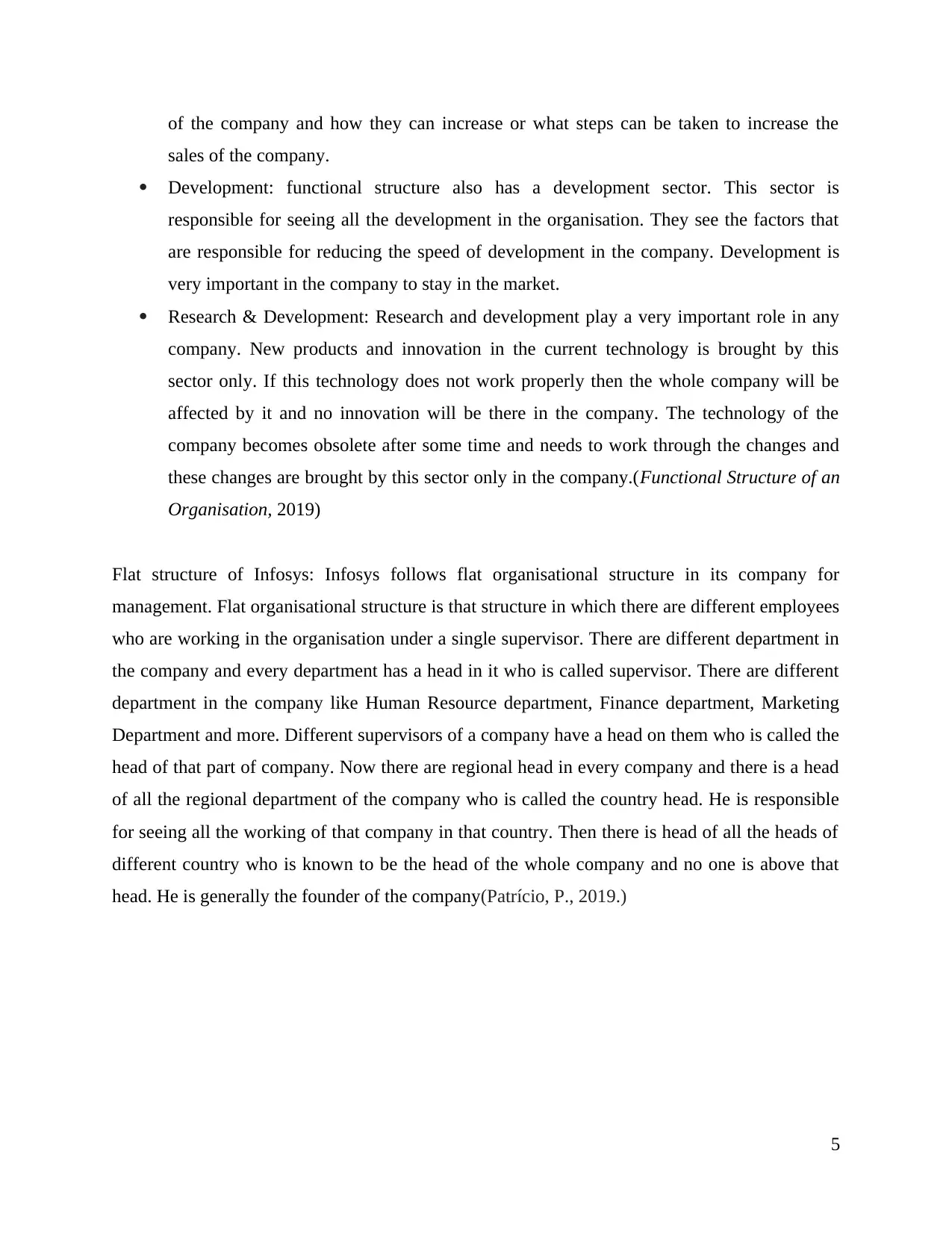
of the company and how they can increase or what steps can be taken to increase the
sales of the company.
Development: functional structure also has a development sector. This sector is
responsible for seeing all the development in the organisation. They see the factors that
are responsible for reducing the speed of development in the company. Development is
very important in the company to stay in the market.
Research & Development: Research and development play a very important role in any
company. New products and innovation in the current technology is brought by this
sector only. If this technology does not work properly then the whole company will be
affected by it and no innovation will be there in the company. The technology of the
company becomes obsolete after some time and needs to work through the changes and
these changes are brought by this sector only in the company.(Functional Structure of an
Organisation, 2019)
Flat structure of Infosys: Infosys follows flat organisational structure in its company for
management. Flat organisational structure is that structure in which there are different employees
who are working in the organisation under a single supervisor. There are different department in
the company and every department has a head in it who is called supervisor. There are different
department in the company like Human Resource department, Finance department, Marketing
Department and more. Different supervisors of a company have a head on them who is called the
head of that part of company. Now there are regional head in every company and there is a head
of all the regional department of the company who is called the country head. He is responsible
for seeing all the working of that company in that country. Then there is head of all the heads of
different country who is known to be the head of the whole company and no one is above that
head. He is generally the founder of the company(Patrício, P., 2019.)
5
sales of the company.
Development: functional structure also has a development sector. This sector is
responsible for seeing all the development in the organisation. They see the factors that
are responsible for reducing the speed of development in the company. Development is
very important in the company to stay in the market.
Research & Development: Research and development play a very important role in any
company. New products and innovation in the current technology is brought by this
sector only. If this technology does not work properly then the whole company will be
affected by it and no innovation will be there in the company. The technology of the
company becomes obsolete after some time and needs to work through the changes and
these changes are brought by this sector only in the company.(Functional Structure of an
Organisation, 2019)
Flat structure of Infosys: Infosys follows flat organisational structure in its company for
management. Flat organisational structure is that structure in which there are different employees
who are working in the organisation under a single supervisor. There are different department in
the company and every department has a head in it who is called supervisor. There are different
department in the company like Human Resource department, Finance department, Marketing
Department and more. Different supervisors of a company have a head on them who is called the
head of that part of company. Now there are regional head in every company and there is a head
of all the regional department of the company who is called the country head. He is responsible
for seeing all the working of that company in that country. Then there is head of all the heads of
different country who is known to be the head of the whole company and no one is above that
head. He is generally the founder of the company(Patrício, P., 2019.)
5
Secure Best Marks with AI Grader
Need help grading? Try our AI Grader for instant feedback on your assignments.
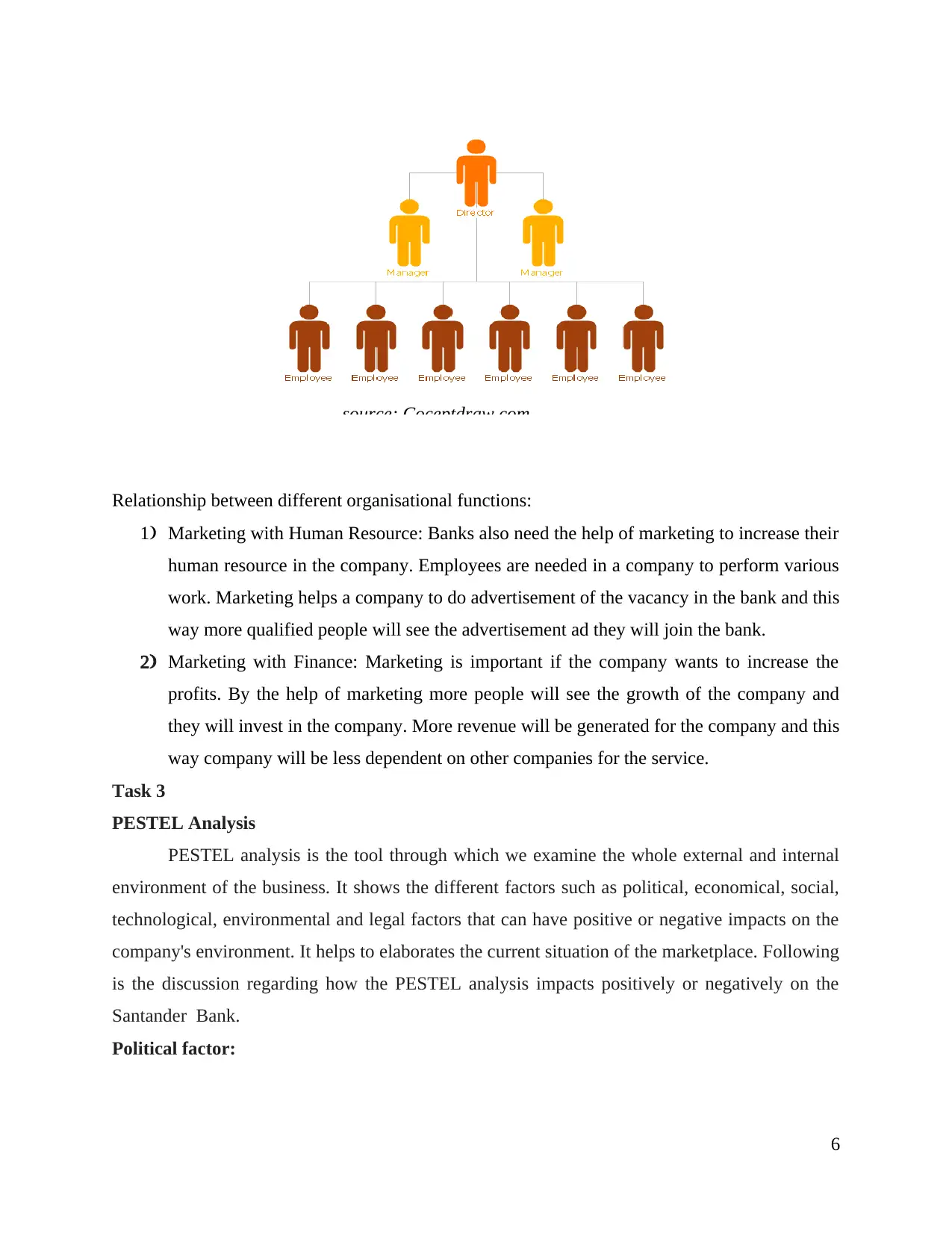
Relationship between different organisational functions:
1) Marketing with Human Resource: Banks also need the help of marketing to increase their
human resource in the company. Employees are needed in a company to perform various
work. Marketing helps a company to do advertisement of the vacancy in the bank and this
way more qualified people will see the advertisement ad they will join the bank.
2) Marketing with Finance: Marketing is important if the company wants to increase the
profits. By the help of marketing more people will see the growth of the company and
they will invest in the company. More revenue will be generated for the company and this
way company will be less dependent on other companies for the service.
Task 3
PESTEL Analysis
PESTEL analysis is the tool through which we examine the whole external and internal
environment of the business. It shows the different factors such as political, economical, social,
technological, environmental and legal factors that can have positive or negative impacts on the
company's environment. It helps to elaborates the current situation of the marketplace. Following
is the discussion regarding how the PESTEL analysis impacts positively or negatively on the
Santander Bank.
Political factor:
6
source: Coceptdraw.com
1) Marketing with Human Resource: Banks also need the help of marketing to increase their
human resource in the company. Employees are needed in a company to perform various
work. Marketing helps a company to do advertisement of the vacancy in the bank and this
way more qualified people will see the advertisement ad they will join the bank.
2) Marketing with Finance: Marketing is important if the company wants to increase the
profits. By the help of marketing more people will see the growth of the company and
they will invest in the company. More revenue will be generated for the company and this
way company will be less dependent on other companies for the service.
Task 3
PESTEL Analysis
PESTEL analysis is the tool through which we examine the whole external and internal
environment of the business. It shows the different factors such as political, economical, social,
technological, environmental and legal factors that can have positive or negative impacts on the
company's environment. It helps to elaborates the current situation of the marketplace. Following
is the discussion regarding how the PESTEL analysis impacts positively or negatively on the
Santander Bank.
Political factor:
6
source: Coceptdraw.com
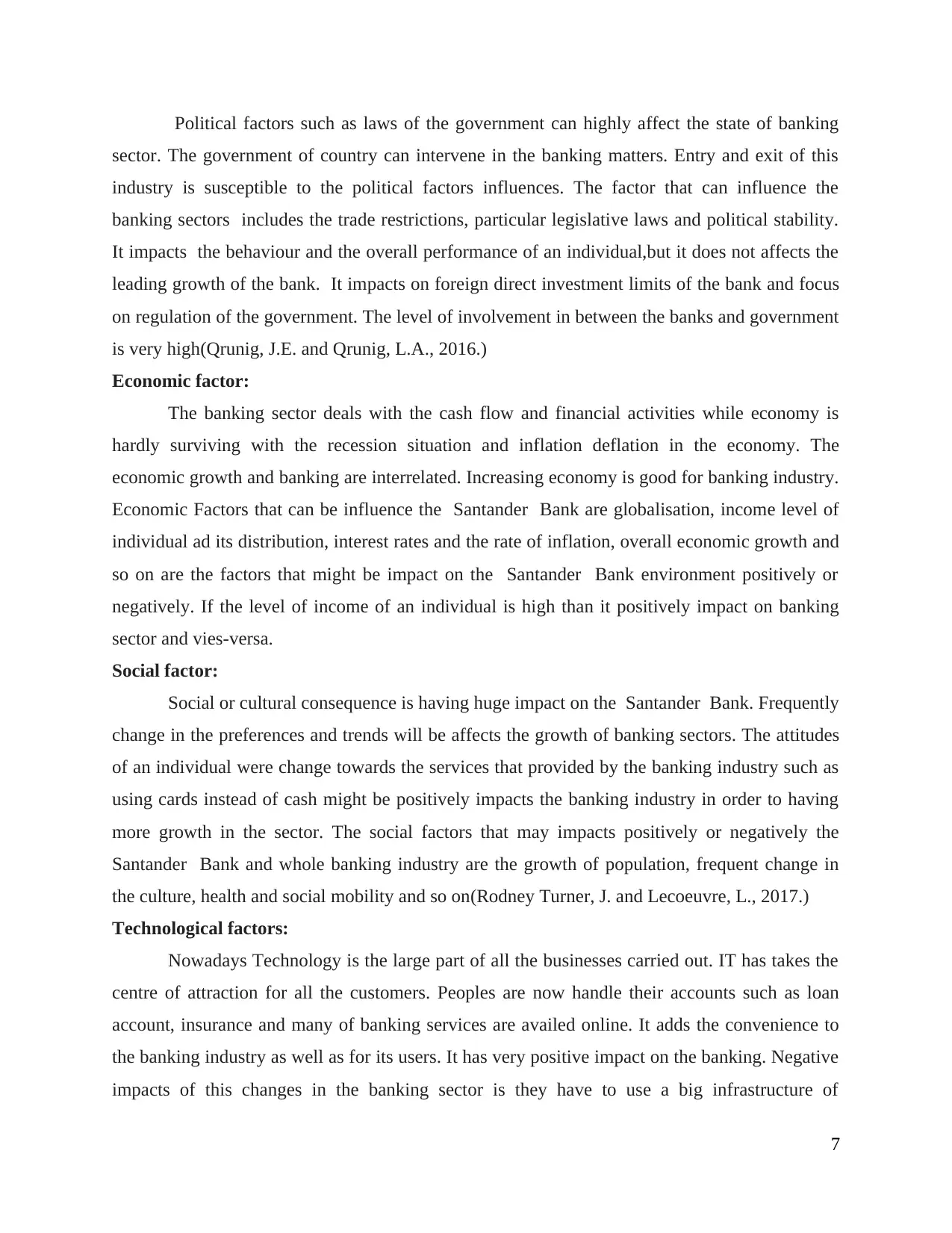
Political factors such as laws of the government can highly affect the state of banking
sector. The government of country can intervene in the banking matters. Entry and exit of this
industry is susceptible to the political factors influences. The factor that can influence the
banking sectors includes the trade restrictions, particular legislative laws and political stability.
It impacts the behaviour and the overall performance of an individual,but it does not affects the
leading growth of the bank. It impacts on foreign direct investment limits of the bank and focus
on regulation of the government. The level of involvement in between the banks and government
is very high(Qrunig, J.E. and Qrunig, L.A., 2016.)
Economic factor:
The banking sector deals with the cash flow and financial activities while economy is
hardly surviving with the recession situation and inflation deflation in the economy. The
economic growth and banking are interrelated. Increasing economy is good for banking industry.
Economic Factors that can be influence the Santander Bank are globalisation, income level of
individual ad its distribution, interest rates and the rate of inflation, overall economic growth and
so on are the factors that might be impact on the Santander Bank environment positively or
negatively. If the level of income of an individual is high than it positively impact on banking
sector and vies-versa.
Social factor:
Social or cultural consequence is having huge impact on the Santander Bank. Frequently
change in the preferences and trends will be affects the growth of banking sectors. The attitudes
of an individual were change towards the services that provided by the banking industry such as
using cards instead of cash might be positively impacts the banking industry in order to having
more growth in the sector. The social factors that may impacts positively or negatively the
Santander Bank and whole banking industry are the growth of population, frequent change in
the culture, health and social mobility and so on(Rodney Turner, J. and Lecoeuvre, L., 2017.)
Technological factors:
Nowadays Technology is the large part of all the businesses carried out. IT has takes the
centre of attraction for all the customers. Peoples are now handle their accounts such as loan
account, insurance and many of banking services are availed online. It adds the convenience to
the banking industry as well as for its users. It has very positive impact on the banking. Negative
impacts of this changes in the banking sector is they have to use a big infrastructure of
7
sector. The government of country can intervene in the banking matters. Entry and exit of this
industry is susceptible to the political factors influences. The factor that can influence the
banking sectors includes the trade restrictions, particular legislative laws and political stability.
It impacts the behaviour and the overall performance of an individual,but it does not affects the
leading growth of the bank. It impacts on foreign direct investment limits of the bank and focus
on regulation of the government. The level of involvement in between the banks and government
is very high(Qrunig, J.E. and Qrunig, L.A., 2016.)
Economic factor:
The banking sector deals with the cash flow and financial activities while economy is
hardly surviving with the recession situation and inflation deflation in the economy. The
economic growth and banking are interrelated. Increasing economy is good for banking industry.
Economic Factors that can be influence the Santander Bank are globalisation, income level of
individual ad its distribution, interest rates and the rate of inflation, overall economic growth and
so on are the factors that might be impact on the Santander Bank environment positively or
negatively. If the level of income of an individual is high than it positively impact on banking
sector and vies-versa.
Social factor:
Social or cultural consequence is having huge impact on the Santander Bank. Frequently
change in the preferences and trends will be affects the growth of banking sectors. The attitudes
of an individual were change towards the services that provided by the banking industry such as
using cards instead of cash might be positively impacts the banking industry in order to having
more growth in the sector. The social factors that may impacts positively or negatively the
Santander Bank and whole banking industry are the growth of population, frequent change in
the culture, health and social mobility and so on(Rodney Turner, J. and Lecoeuvre, L., 2017.)
Technological factors:
Nowadays Technology is the large part of all the businesses carried out. IT has takes the
centre of attraction for all the customers. Peoples are now handle their accounts such as loan
account, insurance and many of banking services are availed online. It adds the convenience to
the banking industry as well as for its users. It has very positive impact on the banking. Negative
impacts of this changes in the banking sector is they have to use a big infrastructure of
7
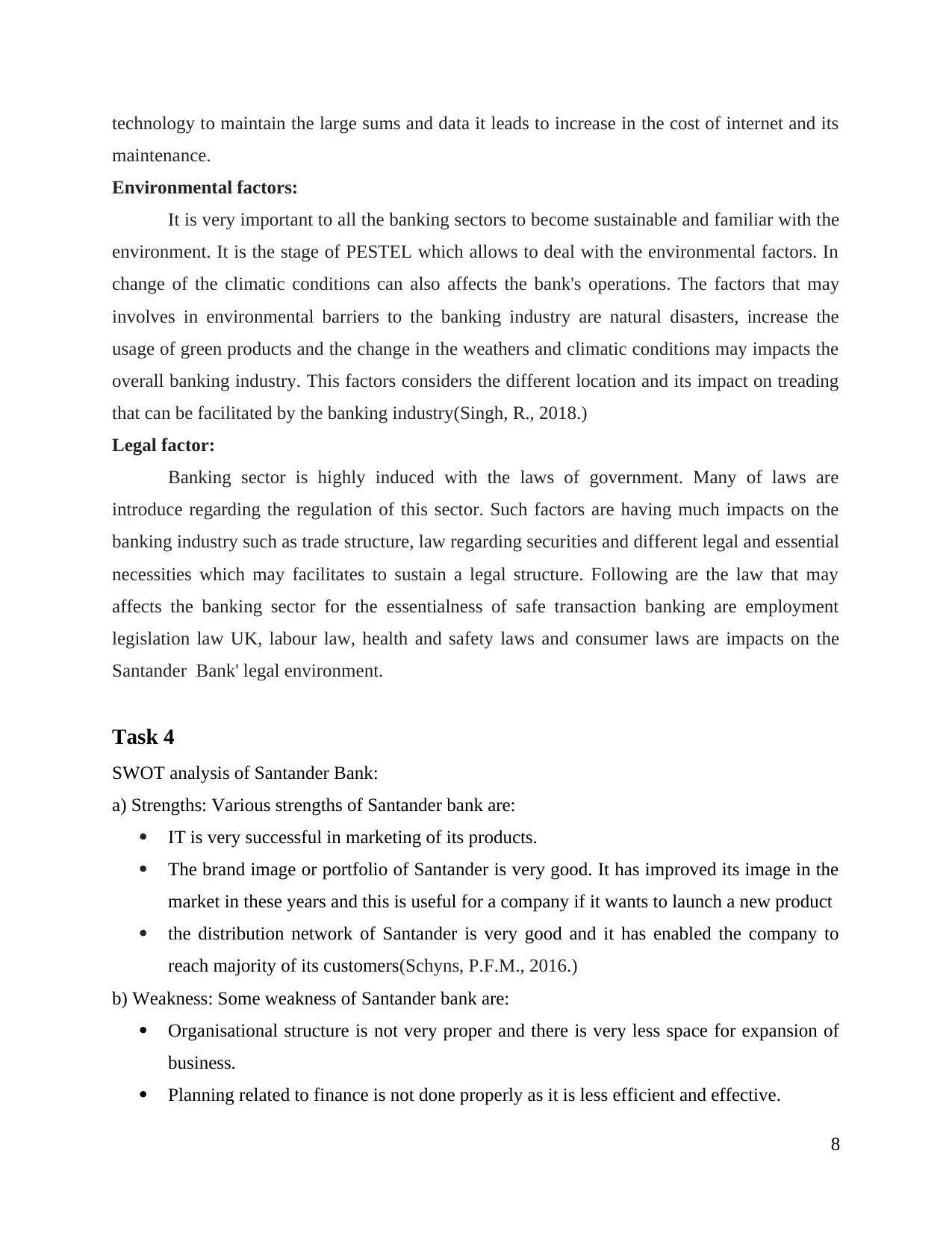
technology to maintain the large sums and data it leads to increase in the cost of internet and its
maintenance.
Environmental factors:
It is very important to all the banking sectors to become sustainable and familiar with the
environment. It is the stage of PESTEL which allows to deal with the environmental factors. In
change of the climatic conditions can also affects the bank's operations. The factors that may
involves in environmental barriers to the banking industry are natural disasters, increase the
usage of green products and the change in the weathers and climatic conditions may impacts the
overall banking industry. This factors considers the different location and its impact on treading
that can be facilitated by the banking industry(Singh, R., 2018.)
Legal factor:
Banking sector is highly induced with the laws of government. Many of laws are
introduce regarding the regulation of this sector. Such factors are having much impacts on the
banking industry such as trade structure, law regarding securities and different legal and essential
necessities which may facilitates to sustain a legal structure. Following are the law that may
affects the banking sector for the essentialness of safe transaction banking are employment
legislation law UK, labour law, health and safety laws and consumer laws are impacts on the
Santander Bank' legal environment.
Task 4
SWOT analysis of Santander Bank:
a) Strengths: Various strengths of Santander bank are:
IT is very successful in marketing of its products.
The brand image or portfolio of Santander is very good. It has improved its image in the
market in these years and this is useful for a company if it wants to launch a new product
the distribution network of Santander is very good and it has enabled the company to
reach majority of its customers(Schyns, P.F.M., 2016.)
b) Weakness: Some weakness of Santander bank are:
Organisational structure is not very proper and there is very less space for expansion of
business.
Planning related to finance is not done properly as it is less efficient and effective.
8
maintenance.
Environmental factors:
It is very important to all the banking sectors to become sustainable and familiar with the
environment. It is the stage of PESTEL which allows to deal with the environmental factors. In
change of the climatic conditions can also affects the bank's operations. The factors that may
involves in environmental barriers to the banking industry are natural disasters, increase the
usage of green products and the change in the weathers and climatic conditions may impacts the
overall banking industry. This factors considers the different location and its impact on treading
that can be facilitated by the banking industry(Singh, R., 2018.)
Legal factor:
Banking sector is highly induced with the laws of government. Many of laws are
introduce regarding the regulation of this sector. Such factors are having much impacts on the
banking industry such as trade structure, law regarding securities and different legal and essential
necessities which may facilitates to sustain a legal structure. Following are the law that may
affects the banking sector for the essentialness of safe transaction banking are employment
legislation law UK, labour law, health and safety laws and consumer laws are impacts on the
Santander Bank' legal environment.
Task 4
SWOT analysis of Santander Bank:
a) Strengths: Various strengths of Santander bank are:
IT is very successful in marketing of its products.
The brand image or portfolio of Santander is very good. It has improved its image in the
market in these years and this is useful for a company if it wants to launch a new product
the distribution network of Santander is very good and it has enabled the company to
reach majority of its customers(Schyns, P.F.M., 2016.)
b) Weakness: Some weakness of Santander bank are:
Organisational structure is not very proper and there is very less space for expansion of
business.
Planning related to finance is not done properly as it is less efficient and effective.
8
Paraphrase This Document
Need a fresh take? Get an instant paraphrase of this document with our AI Paraphraser
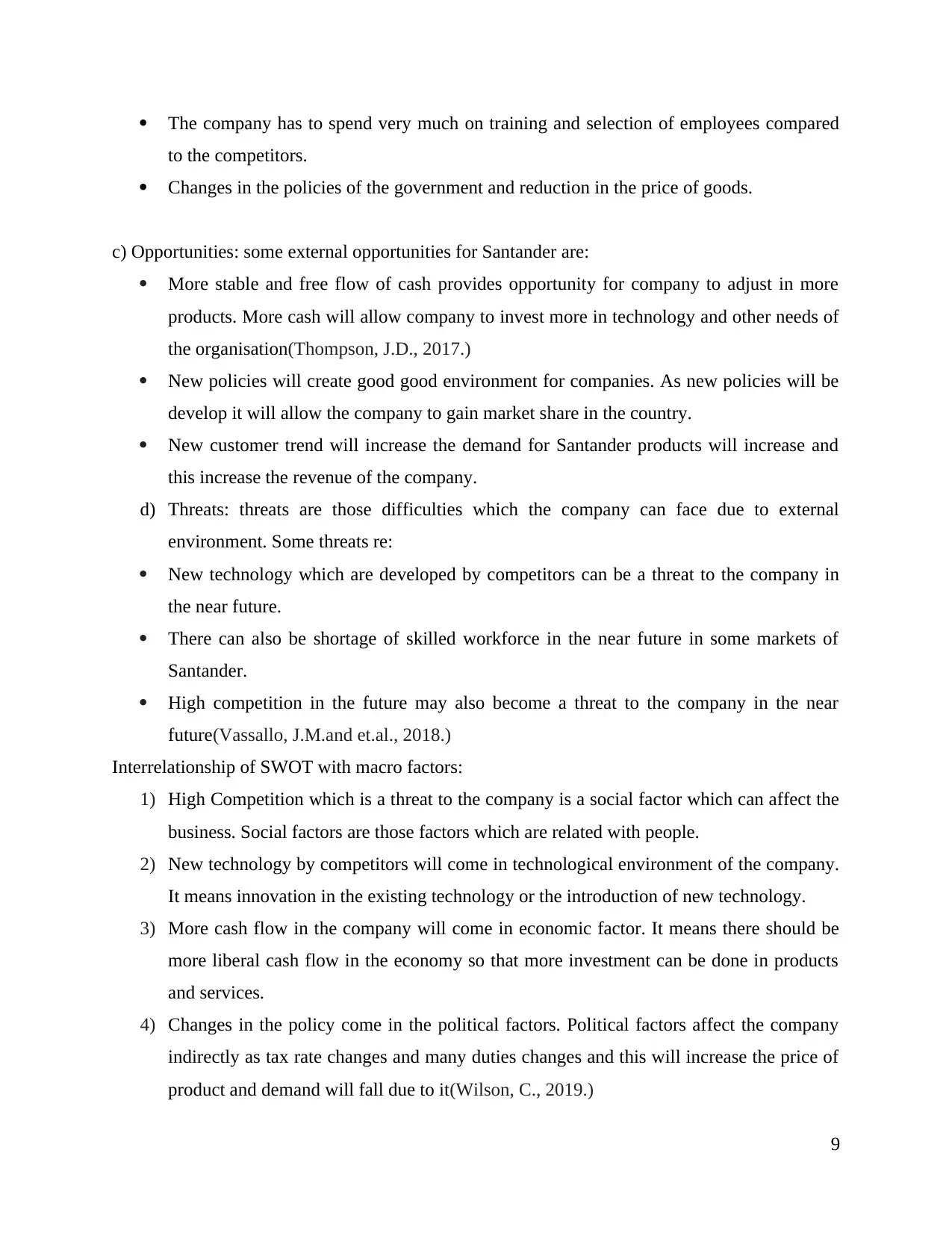
The company has to spend very much on training and selection of employees compared
to the competitors.
Changes in the policies of the government and reduction in the price of goods.
c) Opportunities: some external opportunities for Santander are:
More stable and free flow of cash provides opportunity for company to adjust in more
products. More cash will allow company to invest more in technology and other needs of
the organisation(Thompson, J.D., 2017.)
New policies will create good good environment for companies. As new policies will be
develop it will allow the company to gain market share in the country.
New customer trend will increase the demand for Santander products will increase and
this increase the revenue of the company.
d) Threats: threats are those difficulties which the company can face due to external
environment. Some threats re:
New technology which are developed by competitors can be a threat to the company in
the near future.
There can also be shortage of skilled workforce in the near future in some markets of
Santander.
High competition in the future may also become a threat to the company in the near
future(Vassallo, J.M.and et.al., 2018.)
Interrelationship of SWOT with macro factors:
1) High Competition which is a threat to the company is a social factor which can affect the
business. Social factors are those factors which are related with people.
2) New technology by competitors will come in technological environment of the company.
It means innovation in the existing technology or the introduction of new technology.
3) More cash flow in the company will come in economic factor. It means there should be
more liberal cash flow in the economy so that more investment can be done in products
and services.
4) Changes in the policy come in the political factors. Political factors affect the company
indirectly as tax rate changes and many duties changes and this will increase the price of
product and demand will fall due to it(Wilson, C., 2019.)
9
to the competitors.
Changes in the policies of the government and reduction in the price of goods.
c) Opportunities: some external opportunities for Santander are:
More stable and free flow of cash provides opportunity for company to adjust in more
products. More cash will allow company to invest more in technology and other needs of
the organisation(Thompson, J.D., 2017.)
New policies will create good good environment for companies. As new policies will be
develop it will allow the company to gain market share in the country.
New customer trend will increase the demand for Santander products will increase and
this increase the revenue of the company.
d) Threats: threats are those difficulties which the company can face due to external
environment. Some threats re:
New technology which are developed by competitors can be a threat to the company in
the near future.
There can also be shortage of skilled workforce in the near future in some markets of
Santander.
High competition in the future may also become a threat to the company in the near
future(Vassallo, J.M.and et.al., 2018.)
Interrelationship of SWOT with macro factors:
1) High Competition which is a threat to the company is a social factor which can affect the
business. Social factors are those factors which are related with people.
2) New technology by competitors will come in technological environment of the company.
It means innovation in the existing technology or the introduction of new technology.
3) More cash flow in the company will come in economic factor. It means there should be
more liberal cash flow in the economy so that more investment can be done in products
and services.
4) Changes in the policy come in the political factors. Political factors affect the company
indirectly as tax rate changes and many duties changes and this will increase the price of
product and demand will fall due to it(Wilson, C., 2019.)
9
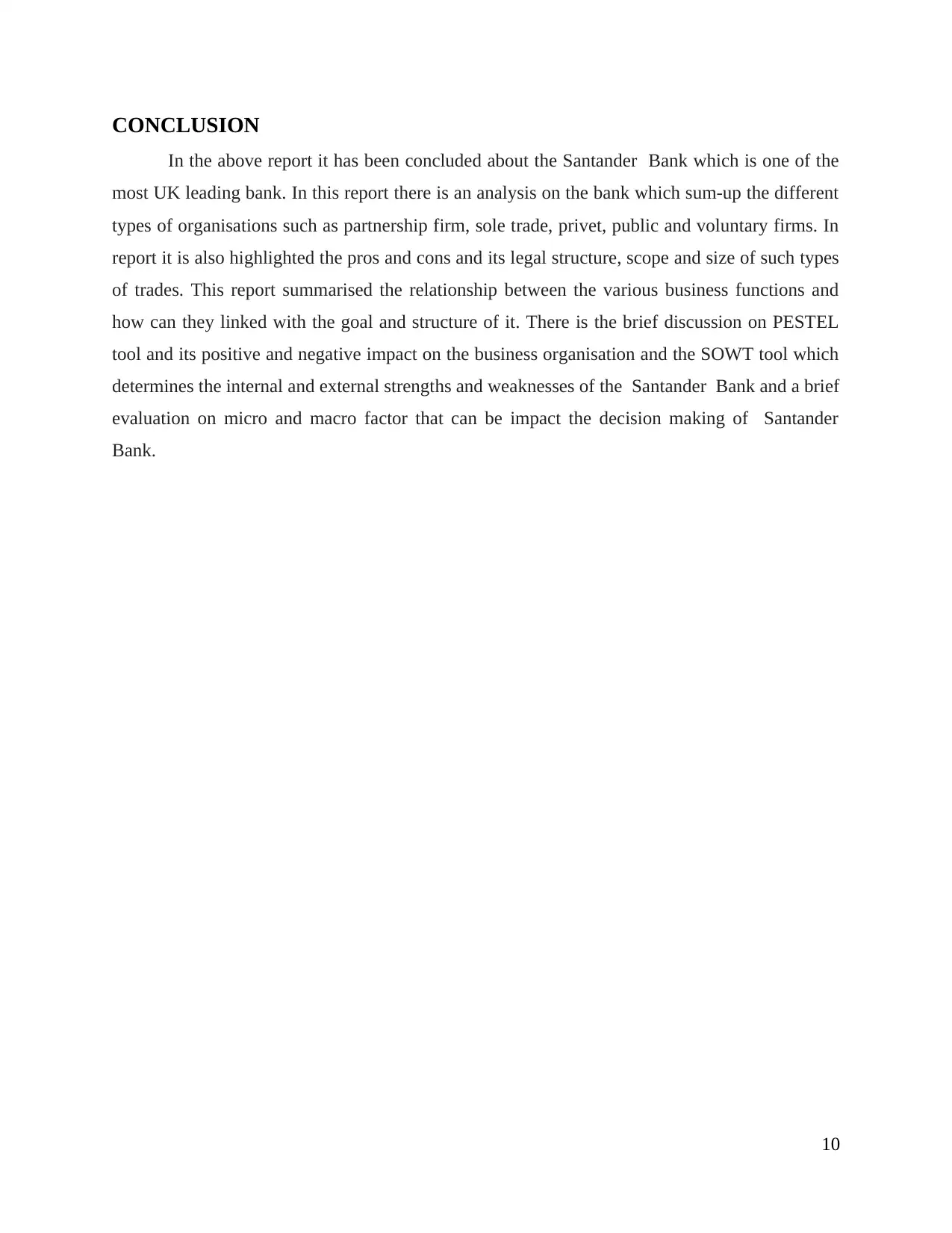
CONCLUSION
In the above report it has been concluded about the Santander Bank which is one of the
most UK leading bank. In this report there is an analysis on the bank which sum-up the different
types of organisations such as partnership firm, sole trade, privet, public and voluntary firms. In
report it is also highlighted the pros and cons and its legal structure, scope and size of such types
of trades. This report summarised the relationship between the various business functions and
how can they linked with the goal and structure of it. There is the brief discussion on PESTEL
tool and its positive and negative impact on the business organisation and the SOWT tool which
determines the internal and external strengths and weaknesses of the Santander Bank and a brief
evaluation on micro and macro factor that can be impact the decision making of Santander
Bank.
10
In the above report it has been concluded about the Santander Bank which is one of the
most UK leading bank. In this report there is an analysis on the bank which sum-up the different
types of organisations such as partnership firm, sole trade, privet, public and voluntary firms. In
report it is also highlighted the pros and cons and its legal structure, scope and size of such types
of trades. This report summarised the relationship between the various business functions and
how can they linked with the goal and structure of it. There is the brief discussion on PESTEL
tool and its positive and negative impact on the business organisation and the SOWT tool which
determines the internal and external strengths and weaknesses of the Santander Bank and a brief
evaluation on micro and macro factor that can be impact the decision making of Santander
Bank.
10
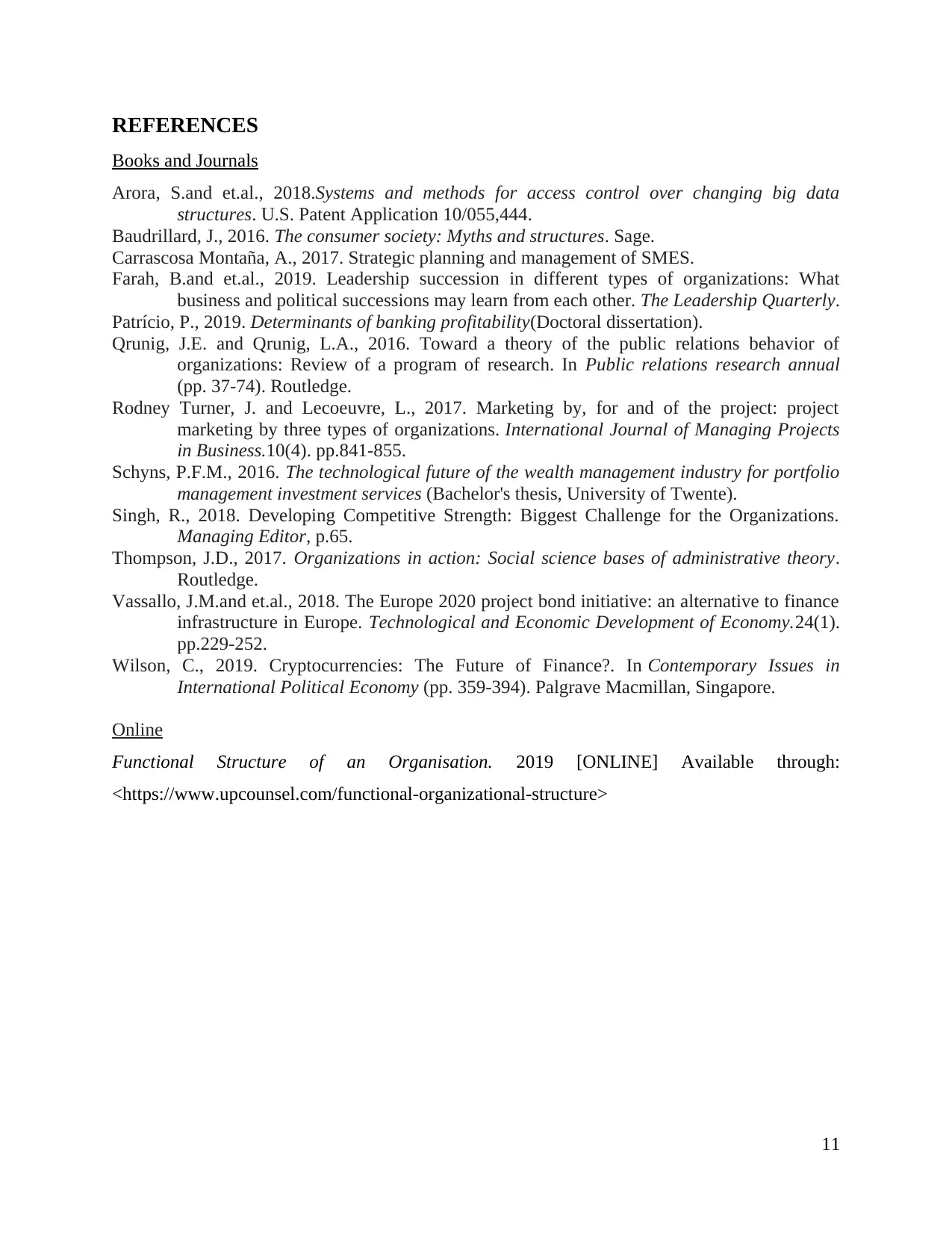
REFERENCES
Books and Journals
Arora, S.and et.al., 2018.Systems and methods for access control over changing big data
structures. U.S. Patent Application 10/055,444.
Baudrillard, J., 2016. The consumer society: Myths and structures. Sage.
Carrascosa Montaña, A., 2017. Strategic planning and management of SMES.
Farah, B.and et.al., 2019. Leadership succession in different types of organizations: What
business and political successions may learn from each other. The Leadership Quarterly.
Patrício, P., 2019. Determinants of banking profitability(Doctoral dissertation).
Qrunig, J.E. and Qrunig, L.A., 2016. Toward a theory of the public relations behavior of
organizations: Review of a program of research. In Public relations research annual
(pp. 37-74). Routledge.
Rodney Turner, J. and Lecoeuvre, L., 2017. Marketing by, for and of the project: project
marketing by three types of organizations. International Journal of Managing Projects
in Business.10(4). pp.841-855.
Schyns, P.F.M., 2016. The technological future of the wealth management industry for portfolio
management investment services (Bachelor's thesis, University of Twente).
Singh, R., 2018. Developing Competitive Strength: Biggest Challenge for the Organizations.
Managing Editor, p.65.
Thompson, J.D., 2017. Organizations in action: Social science bases of administrative theory.
Routledge.
Vassallo, J.M.and et.al., 2018. The Europe 2020 project bond initiative: an alternative to finance
infrastructure in Europe. Technological and Economic Development of Economy.24(1).
pp.229-252.
Wilson, C., 2019. Cryptocurrencies: The Future of Finance?. In Contemporary Issues in
International Political Economy (pp. 359-394). Palgrave Macmillan, Singapore.
Online
Functional Structure of an Organisation. 2019 [ONLINE] Available through:
<https://www.upcounsel.com/functional-organizational-structure>
11
Books and Journals
Arora, S.and et.al., 2018.Systems and methods for access control over changing big data
structures. U.S. Patent Application 10/055,444.
Baudrillard, J., 2016. The consumer society: Myths and structures. Sage.
Carrascosa Montaña, A., 2017. Strategic planning and management of SMES.
Farah, B.and et.al., 2019. Leadership succession in different types of organizations: What
business and political successions may learn from each other. The Leadership Quarterly.
Patrício, P., 2019. Determinants of banking profitability(Doctoral dissertation).
Qrunig, J.E. and Qrunig, L.A., 2016. Toward a theory of the public relations behavior of
organizations: Review of a program of research. In Public relations research annual
(pp. 37-74). Routledge.
Rodney Turner, J. and Lecoeuvre, L., 2017. Marketing by, for and of the project: project
marketing by three types of organizations. International Journal of Managing Projects
in Business.10(4). pp.841-855.
Schyns, P.F.M., 2016. The technological future of the wealth management industry for portfolio
management investment services (Bachelor's thesis, University of Twente).
Singh, R., 2018. Developing Competitive Strength: Biggest Challenge for the Organizations.
Managing Editor, p.65.
Thompson, J.D., 2017. Organizations in action: Social science bases of administrative theory.
Routledge.
Vassallo, J.M.and et.al., 2018. The Europe 2020 project bond initiative: an alternative to finance
infrastructure in Europe. Technological and Economic Development of Economy.24(1).
pp.229-252.
Wilson, C., 2019. Cryptocurrencies: The Future of Finance?. In Contemporary Issues in
International Political Economy (pp. 359-394). Palgrave Macmillan, Singapore.
Online
Functional Structure of an Organisation. 2019 [ONLINE] Available through:
<https://www.upcounsel.com/functional-organizational-structure>
11
1 out of 13
![[object Object]](/_next/static/media/star-bottom.7253800d.svg)





